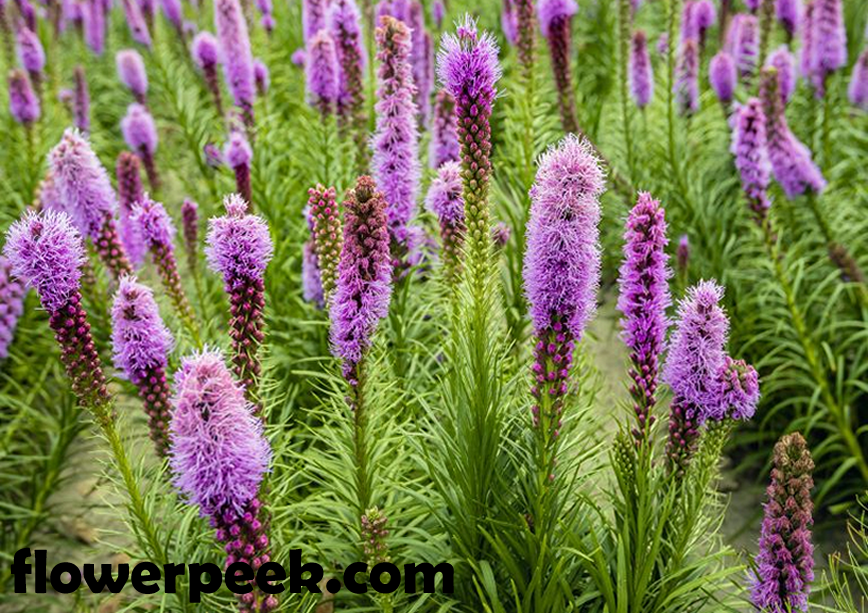The botanical name of Liatris is Liatris
spicata. The plants belong to the large aster (Asteraceae) family and they are
also known as gayfeather or blazing star. The Liatris plant is a long-blooming
perennial wildflower that is native to eastern North America. The liatris plants
have a highly unusual flower heads that features tiny star-like blossoms
arranged around the long upright bottle-brush spire. The Liatris plants are usually
planted from potted nursery starts or from corms in the spring after the last
frost date. Starting the Liatris plants from seeds is also possible, although
it can take about 2 to 3 years for the Liatris plants to flower. Below is the
basic information about Liatris plants
Liatris Plant Info
The common name: The common names are
dense blazing star, liatris, blazing star, gay feather.
The botanical name: The botanical name
is Liatris spicata.
Family: Liatris is a member of Asteraceae
family.
The plant type: The plant is herbaceous
perennial.
The mature size: The mature size is
about two to four feet tall, nine to eighteen inches wide.
The sun exposure: The plant prefers full.
The soil type: The plant does well in
medium-moisture, well-drained soil.
The soil pH: Acidic to neutral (5.5
to 7.5)
The blooming time: The blooming time
is summer to early fall.
The flower color: The flower colors
are white, purple, and reddish-purple.
USDA Hardiness Zones: The plant is
suitable in USDA Hardiness Zones 3 through 9.
The native area: Liatris is native to
Eastern North America.
Liatris Plant Care
Like I said earlier, Liatris can actually
be planted from potted nursery starts, although it is much more economical to
plant the Liatris from bulb-like root structures bought in bulk.
Light requirement: Make sure you choose
a site with full sun to plant your liatris corms. Actually these are prairie
plants in their native habitat, so the more sun the better the liatris plant
will perform.
Soil requirement: Any soil with good
fertility level can successfully grow Liatris corms, although quick drainage is
important to prevent rot. Very rich soils may require that you stake the Liatris
plants, as the stalks can be a bit floppy. The Liatris plants prefer a slightly
acidic to neutral soil pH. Heavy clay can easily cause root rot, most especially
in winter, if the soil does not drain well.
Water requirement: After planting you
need to water the corms thoroughly. The corms need no additional irrigation
until the stalks sprout. As the Liatris plants begin active growth, one inch of
water a week during the hottest months will prevent stunted flowers and leaf
scorch. Apply water to the base of the Liatris plants, or you can use drip
irrigation in other to avoid spreading fungal diseases.
The Liatris plants need more water in
their first year; afterward, the plants have very good tolerance to drought and
dry soil conditions.
Temperature and humidity requirement:
Hardy in zones three to nine, Liatris plants is quite tolerant of summer heat
and humidity in warm climates, and will nicely survive very cold winters
provided that the soil is not too wet. Wet winter soils can easily cause the
corms to rot.
Fertilizer requirement: Liatris plants
are not a heavy feeder, but if the soil fertility is a little bit poor you can
apply a balanced flower fertilizer each spring as active growth begins. In most
decent soils, however, Liatris plants usually does fine with no feeding
whatsoever.
Pest and disease control: Liatris plants
does not actually suffer from any serious insect problems, however several
fungal diseases can occur, including leaf spot, stem rot, rust, powdery mildew,
and verticillium wilt. One of the best approaches is to prevent these diseases
by giving the Liatris plants good sunlight and air circulation. Mild fungal diseases,
such as powdery mildew and leaf spot are usually not serious and may not even
require treatment. More severe diseases sometimes can easily be treated with
fungicides but may be necessary to remove and destroy any badly affected
plants.



Post a Comment